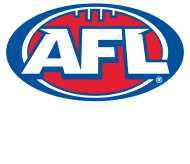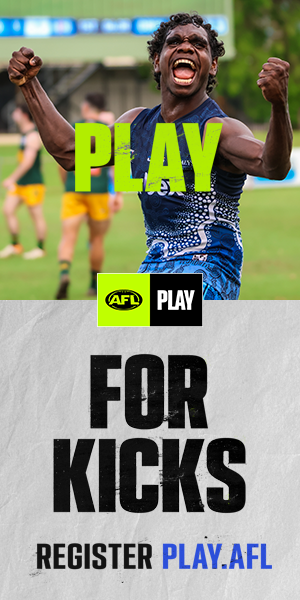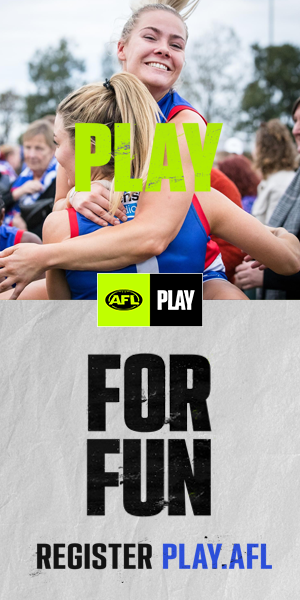It’s a great trivia question. In the Brisbane Lions’ golden era of 2001-02-03-04, when they won three premierships and played in a fourth grand final, who was the only player to win All-Australian selection each year? Michael Voss? Simon Black? Jason Akermanis?
No! Voss, Black and Akermanis, all Brownlow Medallists, were three-time All-Australians in this period. The only four-timer was Nigel Lappin.
Humble, self-effacing and all things modest, he was the under-rated superstar of the aptly-named ‘Fab Four’ but never by those who played with him or were closely involved with the Lions.
When Lappin, a perennial place-getter in the club championship, claimed the Merrett/Murray Medal in 2004 there was collective elation befitting one of the all-time greats.
Coach Leigh Matthews said it best: “As great as Nigel’s reputation was, he was an even better player than his reputation. He wasn’t a limelight player and sometimes high profile and ability get confused. The perfect player wins his own ball, uses it well when he has got it and works very hard to get it back off the opposition. Very few players have done that as well as Nigel.”
The message is clear. Don’t ever understate the qualities and the contribution of the player who wore #44 in arguably the greatest AFL side of all-time. An out-and-out champion who sits comfortably in the AFL Hall of Fame alongside #3, #20 and #12 – Voss, Black and Akermanis.
From the small town of Chiltern in north-east Victoria, a gold-mining area of the 1850s that had one hotel, motel, post office, butcher, bakery, grocery store, petrol station – and no traffic lights – he was born into a footballing family headed by father Jock, who famously kicked 11 goals for Chiltern in his 300th game – the 1982 grand final and coached Chiltern and nearby Brocklesby. It was a family that once had nine members in the same senior side.
Even before he was drafted, the school captain at Rutherglen High had played two years’ senior football with the Chiltern Swans, winning the best and fairest and All-Australian Teal Cup selection as a 17-year-old before being snapped up by the Bears via pick #2 in the 1993 National Draft.
Fortuitously, he arrived at the Gabba at the same time as ex-St.Kilda rover Danny Craven, who was from nearby Wangaratta and had lived in Chiltern from ages 10-15. Another 2023 Hall of Fame inductee, he and wife Kim played host family to the shy midfielder in his first year in Brisbane.
He debuted in Round 3 1993 against Fitzroy at the Gabba, two weeks after soon-to-be best mate Chris Scott and in Paul Roos’ 250th game and was pretty much a fixture in the Bears/Lions side thereafter when fit. If it wasn’t for a bad ankle that cost him the entire 2006 season and an achilles injury four games into 2008 that ended his career, he would have been a 300-gamer.
He played 279 games, including 103 in a row from 1998-2002, to sit fifth on the all-time Lions list. He had 5,911 possessions at 21.2 per game to rank third all-time behind Black and Voss, and kicked 174 goals. He played in the club’s first 23 finals, and finished 5th-3rd-12th-7th-2nd-3rd-7th-4th-1st-10th in the best and fairest from 1996-2005.
A footballer’s footballer, with endless courage, commitment, competitiveness, and consistency, he was equally effective playing back, midfield or forward, and was his own harshest critic – a trait that brought occasional mirth from teammates but endless respect and admiration.
He represented Victoria at State of Origin level in 1996-97-99 when the ‘Big V’ was reserved for the very best, and played in the 2001 International Rules series. After Voss’ retirement in 2006, he shared a five-man captaincy with Jonathan Brown, Simon Black, Luke Power and Chris Johnson.
Always afflicted by asthma, he provided an inspiring example to others when named 1998 Australian Asthma Sportsman of the Year.
He was the centrepiece of one of football’s great stories when he played in the 2003 grand final with two broken ribs and, unknowingly, a punctured lung. Having been crunched late in the preliminary final, he was touch and go all week and wasn’t helped when teammate Akermanis famously told the football world of his injury with TV camaras everywhere.
He faced a gruelling fitness test on grand final eve in which he had to mark high balls and was crunched in a heavy tackle about 15 or 20 times. He got through and 45 minutes before the first bounce declared himself ready to go. Sadly, his inclusion meant Scott, a 2001-02 premiership team member who was on standby after his own injury problems, did not play.
Deployed at half back, Lappin more than did his job in a big win, and in the closing moments dived habitually on a loose ball in heavy traffic. He knew no other way. But post-game he discovered the lung damage suffered in the fitness test, and while teammates flew back to Brisbane with the premiership cup he had to travel by car.
No sooner had he retired he was snapped up by Geelong as a coach in 2009. When Scott was appointed senior coach at the Cats in 2011, they were reunited for what would be another glorious period that he has shared with wife Claire and four daughters – Milla, Chloe, Ally and Meg. He quickly became Scott’s right-hand-man while enjoying the more relaxed lifestyle of Geelong. A little bit like Chiltern.



























































